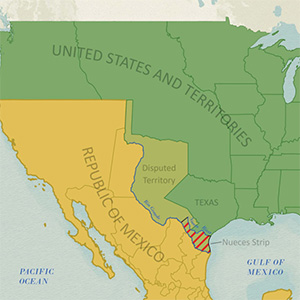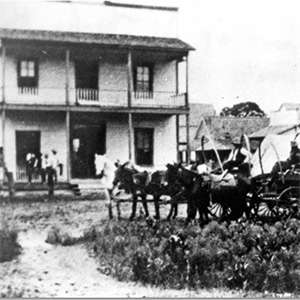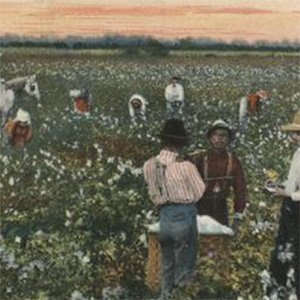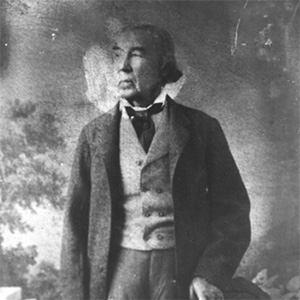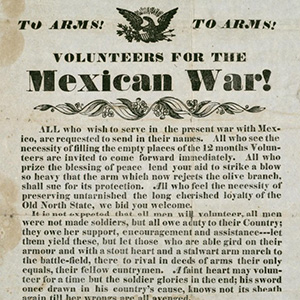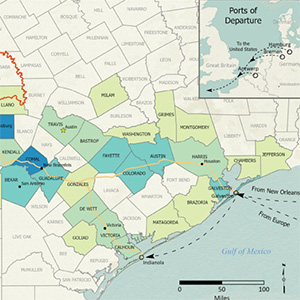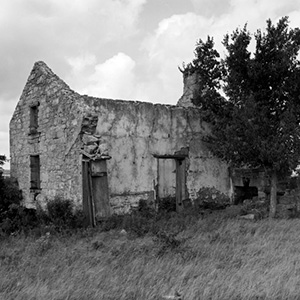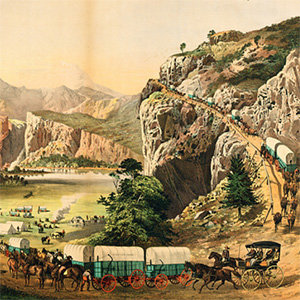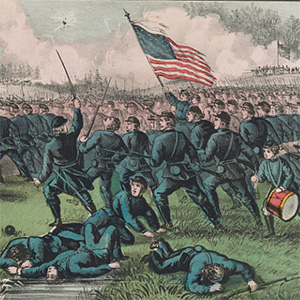In this one-day lesson, students will make observations, inferences, and predictions about the unit based on a primary source image. Students will read a passage examining the key events, major themes, and defining characteristics of the Early Statehood era of Texas history. Students will demonstrate cause-and-effect relationships between key events of the era.
THIS UNIT
Browse unit contents using the tabs to the right or the filters below.
Share
Tell other teachers, parents, and students about us.
Follow
Pacing
10 Estimated Instructional Days; 6 days optional extension lessons; 3 days optional review lessons prior to assessment.
Just the Basics: To meet the TEKS requirements while minimizing the amount of time spent in the unit, educators can focus solely on the following lessons (Approximately 6 - 7 class periods)
- The Big Picture (1 period)
- Vocabulary (2 periods)
- What’s the Story? (1-2 periods)
- U.S. - Mexico War (1 period)
- Early Statehood (1 period)
Contents
Era Overview
The annexation of Texas in 1845 led directly to the U.S.-Mexico War (1846-48), during which Texas served as the staging ground for U.S. armies that invaded both northern and central Mexico. When the war ended with the Treaty of Guadalupe Hidalgo in 1848, the United States took control of a massive swath of land between Texas and California (known as the Mexican Cession) that created the modern U.S.-Mexico border and ignited a political feud between Northerners and Southerners over whether slavery would be allowed to expand into these new western territories
During the twelve years that followed, American settlers poured into Texas. The population of Texas expanded from 212,000 in 1850 to more than 600,000 by 1860. Because the vast majority of these new Texans came from the southern United States, both cotton production and slavery also expanded dramatically. Cotton farming, the mainstay of the Texas economy, boomed: in 1849, Texans exported 58,000 bales of cotton; in 1860, Texans exported 430,000 bales. The enslaved African American population in the state also expanded from 58,000 in 1850 to more than 182,000 by 1860.
Texas, as a result, became increasingly involved in national debates over the future of slavery within the United States. Throughout the 1850s, Texan political leaders aligned themselves with the Deep South states that opposed efforts by the Republican Party and Northern politicians to stop the westward expansion of American slavery. Political turmoil over slavery and westward expansion during the 1850s ultimately led to the secession crisis of 1860-61, and the Civil War that followed. In February 1861, Anglo-Texans voted to leave the United States and soon thereafter joined the Confederate States of America.
Unit Level Downloads (English)
-
Downloadable/Editable versions of the English language unit plan. Provides an Era Overview and pacing, and outlines each lesson’s estimated completion time, essential questions, a description of each lesson, and student learning experiences and activities.
Other Units
Lessons
Most lessons contain downloadable and printable documents, activities, and other resources to aid in classroom instruction. Lesson materials are available in multiple formats and typically contain variations based on learning needs.
The Big Picture
How Do We Know What We Know?
In this one-day lesson, students will use a set of primary source materials from a variety of viewpoints including government documents, a congressional speech, newspaper articles, and travel memoirs to examine significant events and topics related to Texas history during the era of Early Statehood.
Vocabulary
This two-day lesson presents unit vocabulary in short readings that provide the terms in the context of significant information from the unit. Students use the readings to complete vocabulary charts and take an optional vocabulary quiz.
What's the Story?
In this one- to two-day lesson, students will read six short passages to identify and explain the causes, effects, details, and significance of key events of the era of early Texas statehood.
Who's Who of the Early Texas
In this one or multi-day optional extension lesson, students will read passages about key people of the Early Statehood era to identify and summarize each person’s significance to the era. This lesson includes multiple ways to interact with the materials including biographical fact sheets, a dinner party activity, “I have / Who has” and student worksheets.
The U.S.-Mexico War Guided Notes
In this one-day lesson, students will examine the causes, key events, effects, and significance of the U.S.-Mexico War and complete a guided note-taking worksheet to record key information from a slideshow presentation.
Early Statehood
In this one-day lesson, students will examine the major developments and changes that occurred in Texas from 1845 to 1860 during the Early Statehood era. Topics including population growth, increased immigration, conflicts with frontier Indians, and the Compromise of 1850.
Population & Settlement Extension
In this optional one-day extension lesson, students will take part in a stations activity, analyzing a set of five primary and secondary source materials including maps, graphs, charts, and artifacts to draw conclusions about the effects of population and settlement developments in Texas from 1845 to 1860.
The Compromise of 1850 Extension
In this one-day extension lesson, students will examine the events that caused the creation of the Compromise of 1850, identify the terms of the Compromise, and analyze how the terms affected the growing sectionalism in the United States.
Texas Today
In this one-day lesson, students use reading passages to research how various groups preserve their unique cultures and heritage in Texas today. People groups focused on in this lesson are American Indians, Tejanos, and descendants of German and Polish immigrants.
Looking Ahead
In this one-day lesson, students will analyze a set of primary source materials discussing various topics related to sectionalism in the United States including secession, abolition, and slavery. Students will be able to identify and summarize different arguments and points of view related to each topic.
Study Guide and Flashcards
In this one-day lesson students will review key terms, concepts, and events of Early Statehood in preparation for a unit test. This lesson includes key term review fill-in-the-blank questions with a word bank, matching cause and effect statements, and practice test questions based on new STAAR item types from the 8th grade social studies test including Hot Spot, Short Constructed Response, Multi-Part, and a paper-adapted version of Drag and Drop.
Review Mind Map
In this optional, one-day review lesson, students will create a visual representation of terms and concepts from the unit in a mind map. Students will be able to identify how information from the unit is connected by making connections between terms on a mind map.
Review Bingo Game
In this optional, one-day review lesson, students will review key terms, ideas, people, places, events, and major themes of Early Statehood by playing Bingo using terms from the unit and clues about each term.
Maps
We've assembled the following list of maps that are applicable to the Early Statehood Unit.
Colton's New Map of the State of Texas
"Full color atlas map by county of the state of Texas, showing county towns, post offices, forts, railroads, roads, and water bodies."
The Mexican Boundary from Texas to California
"Map shows major cities, military outposts, boundary lines for Old California, New Mexico, Texas, and Mexico. Includes dates in notes on boundary lines."
The Mexican-American War, first military engagements and incidents 9 April - 18 May 1846
"Map shows troop movements and skirmish locations during the battle of Palo Alto. Includes legend and text about the Battle of Palo Alto."
United States, North America : Northern limit of slavery in Western States shown by Mason & Dixon's Line
"Map shows Mason and Dixon's line from California to Arkansas, state and territorial boundaries, major cities and towns, areas of Indian habitation, and notable geographical features; Washington, Oregon, Nebraska, Kansas, and Indian territories, New Mexico, Utah, Texas, and California."
Map of the United States and territories: showing the possessions and aggressions of the slave power
"Map shows slave holding [dark shaded], non-slave holding [unshaded], and disputed territorries [grayed] parts of the United States during the decade before Civil War. The "Missouri Compromise" is indicated with a parallel line extending from the northern Arkansas border to California."
Map of the Butterfield Trail, Through Taylor County, Texas
"Map of the Butterfield Trail mail route in Taylor County, Texas, in service between September 1858 and 1861, from St. Louis, Missouri, to San Francisco, California."
Colonists' and emigrants' route to Texas
"Map shows pictorial representation of Texas cities, towns, and military posts in European fashion [as if built on a hill]; roads, railroads, steam ship lines into Galveston, "International Overland Route," and rivers; not to scale."
Videos
We provide videos for both continuing education and classroom use. Please see each video's descriptive page for related resources and details about accessibility and viewing options.
Preview of Early Texas Statehood Period
A short introductory video to the Early Statehood Unit. Includes worksheets and/or other attachments.
Annexation and the Road to the U.S.-Mexico War
The annexation of Texas, covering: Republic of Texas on the Brink, Playing the Annexation Game.
The U.S.-Mexico War
The U.S.-Mexico War, covering: James K. Polk Gazes West, Polk Provokes a Fight, War in Northern and Central Mexico, Treaty of Guadalupe Hidalgo, Mexican Cession.
The Crisis of the 1850s
The 1850s in Texas, covering: Aftermath of U.S.-Mexican War, Slave Labor versus Free Labor, Compromise of 1850, Bleeding Kansas, Rise of the Republicans, Dred Scott Decision.
More Resources
The following list of resources provide additional information to help you dive deeper into the context of the unit. Books are linked to OCLC WorldCat, allowing you find a copy in your nearest local library or to make a request for it using interlibrary loan.
General
website Results for Early Statehood in The Portal to Texas History

